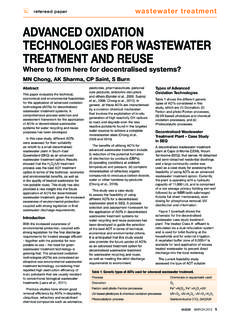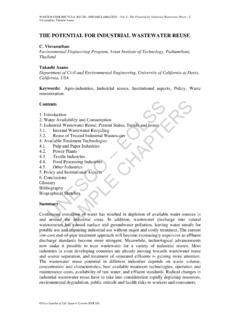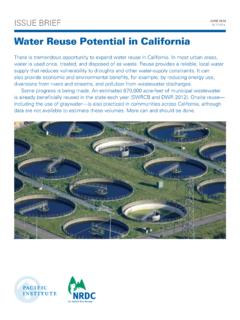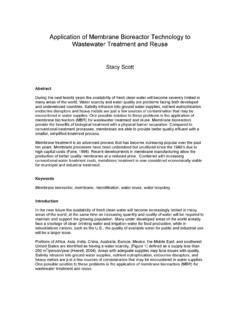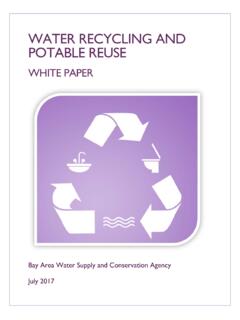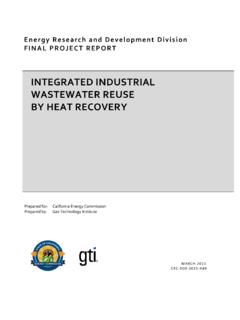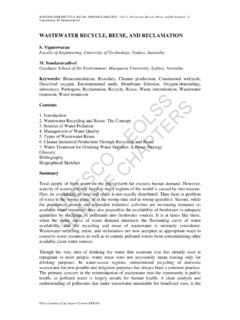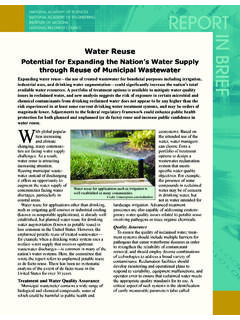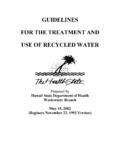Transcription of Recycle and Reuse of Domestic Wastewater - eolss.net
1 UNESCO EOLSSSAMPLE CHAPTERSWASTEWATER Recycle , Reuse , AND RECLAMATION Vol. I - Recycle and Reuse of Domestic Wastewater - S. Vigneswaran, M. Sundaravadivel Encyclopedia of Life Support Systems (EOLSS) Recycle AND Reuse OF Domestic Wastewater S. Vigneswaran Faculty of Engineering, University of Technology, Sydney, Australia M. Sundaravadivel Graduate School of the Environment, Macquarie University, Sydney, Australia Keywords: Blackwater, Dual reticulation, Graywater, Pathogens, Reclamation, Recycle , Reuse , Sludge Contents 1. Introduction 2. History of Wastewater Reuse 3. Motivational Factors for recycling / Reuse 4. Quality Issues of Wastewater Reuse / recycling Pathogen Survival Other Water Quality Parameters Effluent Quality Standards 5. Types of Wastewater Reuse Reuse for Irrigation Irrigation of Agricultural Crops Irrigation of Landscape and Recreational Area Domestic and Industrial Reuse Industrial Reuse Non-potable Domestic Reuse Indirect Potable Reuse Direct Potable Reuse Wastewater Sludge Reuse A Case Study of Sludge Reuse in Japan 6.
2 Future of Water Reuse Appendices Glossary Bibliography Biographical Sketches Summary Reuse of Wastewater for Domestic and agricultural purposes has been occurring since historical times. However, planned Reuse is gained importance only two or three decades ago, as the demands for water dramatically increased due to technological advancement, population growth, and urbanization, which put great stress on the natural water cycle. Reuse of Wastewater for water-demanding activities, which, so far consumed limited freshwater resources is, in effect, imitating the natural water cycle through engineered processes. Several pioneering studies have provided the technological confidence for the safe Reuse of reclaimed water for beneficial uses. While initial emphasis was mainly on Reuse for agricultural and non-potable reuses, the recent trends prove that there are UNESCO EOLSSSAMPLE CHAPTERSWASTEWATER Recycle , Reuse , AND RECLAMATION Vol.
3 I - Recycle and Reuse of Domestic Wastewater - S. Vigneswaran, M. Sundaravadivel Encyclopedia of Life Support Systems (EOLSS) direct Reuse opportunities to applications closer to the point of generation. There are also many projects that have proved to be successful for indirect or direct potable Reuse . All the case studies presented in this article point towards the potential Wastewater has to serve as a viable alternative source of water, in future. 1. Introduction The total supply of freshwater on earth far exceeds human demand. Hydrologists estimated that if all the water available on the planet from oceans, lakes and rivers, the atmosphere, underground aquifers, and in glaciers and snow could be spread over the surface, the earth would be flooded to an overall depth of some three kilometers. About 97 percent of this water is in the oceans, and out of the remaining three percent, only about one-hundredth is the accessible freshwater that can be used for human demand.
4 If this available water could be evenly distributed, still it is enough to support a population about ten times larger than today. The foremost use of water by humans is for the biological survival. However, water need for the biological survival is not the only issue being discussed in the world today. Because, apart from drinking, water is required also for household needs such as cooking, washing, and is vital for our development needs, such as for agriculture and industry. Unfortunately, the available freshwater supplies are not evenly distributed in time and space. Historically, water management has focused on building dams, reservoirs, and diversion canals etc., to make available water wherever needed, and in whatever amount desired. Soaring demands due to rapidly expanding population, industrial expansion, and the need to expand irrigated agriculture, were met by ever larger dams and diversion projects.
5 Dams, river diversions, and irrigation schemes affected both water quality and quantity. Demands on water resources for household, commercial, industrial, and agricultural purposes are increasing greatly. The world population will have grown times over the second half of the twenty-first century, but the worldwide water usage has been growing at more than three times the population growth. In most countries human populations are growing while water availability is not. What is available for use, on a per capita basis, therefore, is falling. Out of 100 countries surveyed by the World Resources Institute in 1986, more than half of them were assessed to have low to very low water availability, and quality of water has been the key issue for the low water availability. Given the rapid spread of water pollution and the growing concern about water availability, the links between quantity and quality of water supplies have become more apparent.
6 In many parts of the world, there is already a widespread scarcity, gradual destruction and increased pollution of freshwater resources. In industrialized countries, widespread shortage of water is caused due to contamination of ground and surface water by industrial effluents, and agricultural chemicals. In many developing countries, industrial pollution is less common, though they are severe near large urban centers. However, untreated sewage poses acute water pollution problems that causes low water availability. Development of human societies is heavily dependent upon availability of water with suitable quality and in adequate quantities, for a variety of uses ranging from Domestic to industrial supplies. An estimate infers that every year, UNESCO EOLSSSAMPLE CHAPTERSWASTEWATER Recycle , Reuse , AND RECLAMATION Vol. I - Recycle and Reuse of Domestic Wastewater - S. Vigneswaran, M.
7 Sundaravadivel Encyclopedia of Life Support Systems (EOLSS) the Wastewater discharges from Domestic , industrial and agricultural practices pollute more than two-thirds of total available run-off through rainfall, thereby, what can be called a man-made water shortages. Thus, in spite of seeming abundance, water scarcity is endemic in most parts of the world. It is because of these concerns, the Agenda 21 adopted by the United Nations Conference on Environment and Development, popularly known as the Earth Summit of Rio de Janeiro, 1992, identified protection and management of freshwater resources from contamination as one of the priority issue, that has to be urgently dealt with to achieve global environmentally sustainable development. The need for increased water requirement for the growing population in the new century is generally assumed, without considering whether available water resources could meet these needs in a sustainable manner.
8 The question about from where the extra water is to come, has led to a scrutiny of present water use strategies. A second look at strategies has thrown a picture of making rational use of already available water, which if used sensibly, there could be enough water for all. The new look invariably points out at Recycle and Reuse of Wastewater that is being increasingly generated due to rapid growth of population and related developmental activities, including agriculture and industrial productions. 2. History of Wastewater Reuse The term Wastewater properly means any water that is no longer wanted, as no further benefits can be derived out of it. About 99 percent of Wastewater is water, and only one percent is solid wastes. An understanding of its potential for Reuse to overcome shortage of freshwater existed in Minoan civilization in ancient Greece, where indications for utilization of Wastewater for agricultural irrigation dates back to 5000 years.
9 Sewage farm practices have been recorded in Germany and UK since 16th and 18th centuries, respectively. Irrigation with sewage and other wastewaters has a long history also in China and India. In the more recent history, the introduction of waterborne sewage collection systems during the 19th century, for discharge of Wastewater into surface water bodies led to indirect use of sewage and other wastewaters as unintentional potable water supplies. Such unplanned water Reuse coupled with inadequate water and Wastewater treatment, resulted in catastrophic epidemics of waterborne diseases during 1840s and 50s. However, when the water supply links with these diseases became clear, engineering solutions were implemented that include the development of alternative water sources using reservoirs and aqueduct systems, relocation of water intakes, and water and Wastewater treatment systems.
10 Controlled Wastewater irrigation has been practiced in sewage farms many countries in Europe, America and Australia since the turn of the current century. For the last three decades or so, the benefits of promoting Wastewater Reuse as a means of supplementing water resources and avoidance of environmental degradation have been recognized by national governments. The value of Wastewater is becoming increasingly understood in arid and semi-arid countries and many countries are now looking forward to ways of improving and expanding Wastewater Reuse practices. UNESCO EOLSSSAMPLE CHAPTERSWASTEWATER Recycle , Reuse , AND RECLAMATION Vol. I - Recycle and Reuse of Domestic Wastewater - S. Vigneswaran, M. Sundaravadivel Encyclopedia of Life Support Systems (EOLSS) Research scientists, aware of both benefits and hazards, are evaluating it as one of the options for future water demands.










